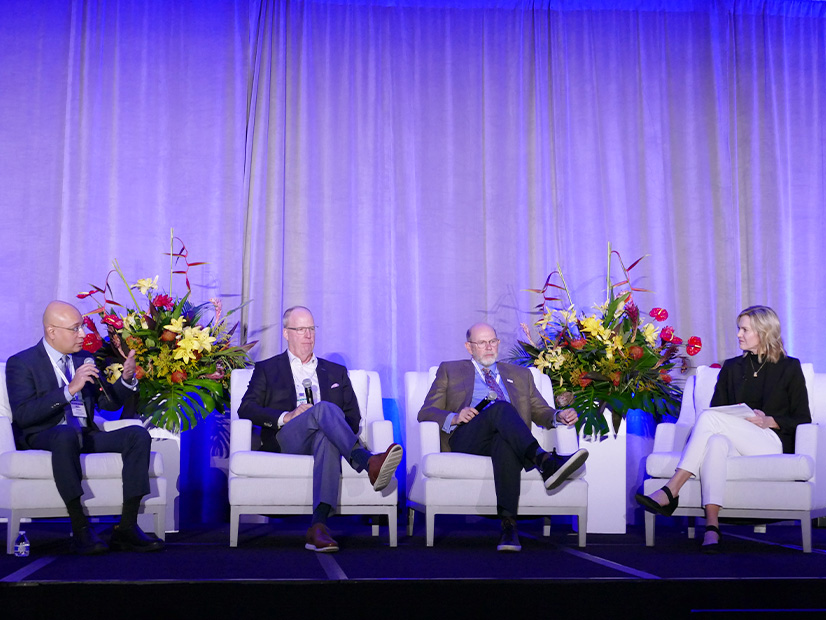
LA QUINTA, Calif. — As pressure grows to decarbonize the electricity sector, grid operators increasingly are grappling with how to coordinate the retirement of traditional resources with the introduction of new non-emitting resources — all while ensuring reliability and affordability.
Challenges of the grid’s transition was a running theme of the discussions among utility regulators and power industry stakeholders at the National Association of Regulatory Utility Commissioners’ Annual Meeting in the Southern California desert Nov. 12 -15.
“In these discussions you get the question of what keeps you up at night,” MISO CEO John Bear said. “The transition … is probably the biggest concern that we have.”
In a Nov. 14 panel, RTO/ISO executives identified the litany of challenges their organizations face as they attempt to retire thermal generation and integrate renewables onto the grid.
“We have to keep the lights on and keep the power affordable through the transition,” PJM CEO Manu Asthana said. “The big difference is the new resources that are coming on are not predictable in the same way that the old resources were.”
With the retirement of thermal generation comes the challenge of ensuring there are enough dependable resources to fill the gap when weather-dependent renewables can’t serve load. The introduction of new technologies has been slow, and if traditional resources are retired too soon, grid operators fear the worst.
“That’s probably one of my biggest concerns, is that we will let these resources that we have, that we use today, retire and not have the replacement resources come in time,” Asthana said. “We just can’t let that happen.”
Asthana pointed out that PJM is on track to retire about 40 GW of resources by 2030; Calpine’s Joseph Kerecman told RTO Insider that may be an understatement. (See PJM Whitepaper to Highlight Future RA Concerns.)
The solution, the CEOs said, is to keep some traditional methods of generation, like natural gas plants, on the grid as long as possible in combination with renewables to ensure reliability.
“There’s a lot of pressure to not build gas infrastructure, but gas is the marginal fuel in our markets,” Asthana said. “We’re approaching this intersection where we know we have to decarbonize the system, but I think we are at risk of not doing so in an orderly fashion.”
NERC CEO Jim Robb emphasized another solution to make a smoother transition: getting better standards in place for inverter-based resources. He noted that while inverter-based resources are currently “grid-following,” they will have to form the grid when they start making up 40 to 60% of the generation mix.
“That’s the path toward a carbon-free grid: having grid-forming technology through power electronics. But we’re not there yet,” he said.
Greater Gas-electric Coordination Needed
Robb said the electric industry is the largest consumer of natural gas, and with the increasing demand for electrification comes a greater need for coordination between the electric and gas sectors.
“If we continue to just build out the electric sector, but we’re not paying attention to the fuel infrastructure behind it, we’re going to run into a lot of issues,” Robb said.
During a Nov. 15 panel, commissioners, regulators and strategists emphasized the need to view and operate the grid as a single entity.
“There’s two separate grids right now,” said Jason Ketchum, vice president at ONE Gas, a Oklahoma-based utility that also serves customers in Texas and Kansas. “There’s a gas grid, and there’s an electric grid, and we need to start talking about the energy grid.”
Diverting from many of the week’s climate-focused conversations, Ketchum emphasized the importance of listening to the customer and recognizing that people in some communities may not have the interest or capability to moderate their lifestyles in the interest of burning less gas.
“We serve a pretty wide geographic area, and a lot of our communities are different,” Ketchum said. “Some are more focused on environmental issues; others are more focused on affordability.”
Georgia Public Service Commissioner Tricia Pridemore, who moderated the panel, asked “if the answer to all of this” was to build more pipelines.
Not necessarily, Ketchum said: Focus on delivering whatever the best asset is to the customer in any given area. But he also emphasized gas as an important economic driver.
“There’s a lot of parts of our region that don’t have gas that can’t grow economically,” he said. “It’s a great opportunity to locate assets in areas that can really help out those communities.”
Getting into GEAR
North Dakota Public Service Commissioner Julie Fedorchak, who was elected NARUC president during the conference, announced a new initiative called Gas-Electric Alignment for Reliability (GEAR).
Led by Pridemore, NARUC’s newly elected vice president, GEAR will bring together a task force of regulators, utilities, grid and pipeline operators, and gas producers and suppliers to help better coordinate the gas and electric industries. Energy officials are hopeful GEAR will initiate meaningful progress toward greater gas-electric coordination to meet the country’s reliability and clean energy needs.
“This is going to be a messy transition, almost guaranteed,” PJM’s Asthana said. “But I’m almost certain we’re going to solve this problem.”

